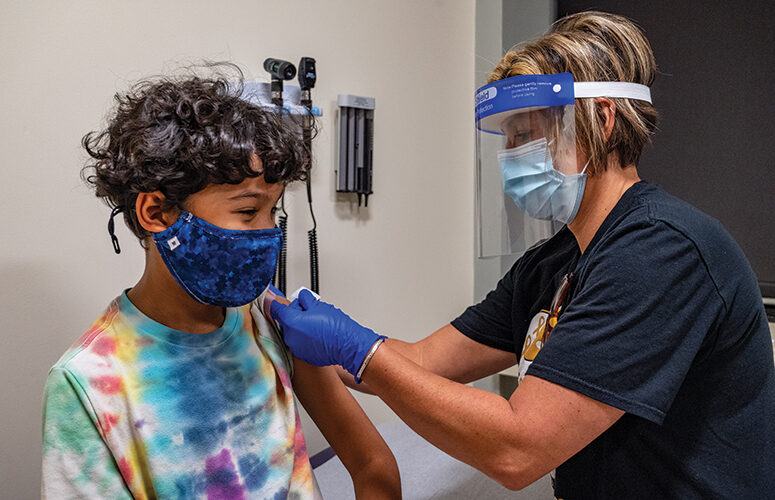
Redesigning Care, Reimagining Education
Addressing Healthcare’s Workforce Shortages
On Apr 10, 2023As the official end of the COVID-19 public health emergency looms in May, one post-pandemic impact that won’t soon go away is the major disruption to the workforce. Many sectors such as hospitality and travel experienced steep job losses in the first months of the pandemic and are now seeing employment stabilizing. Healthcare, on the other hand, entered the pandemic with an existing labor shortage, faced soaring demands for workers throughout the outbreak and sees a continued trajectory of labor needs as the population ages. The U.S. Bureau of Labor Statistics projects a 13% growth rate in healthcare occupations through 2031, much faster than the average for all occupations. All told, this increase is expected to amount to about 2 million new healthcare jobs over a decade.
Healthcare leaders staring at a labor abyss are shifting their focus from the “Great Resignation” to the “Great Reimagination.” Redesigning care models and restructuring education are necessary for this transformational time in healthcare, because the traditional supply-and-demand workforce model is not sustainable. Here’s what labor forecasters predict for the healthcare jobs market over the next decade:
“The COVID-19 pandemic had a significant impact on the nursing workforce,” according to the U.S. Health Resources and Services Administration in its November 2022 report, Nurse Workforce Projections, 2020-2035. Nationally, there is a projected shortage of 78,610 RNs in 2025 and a shortage of 63,720 RNs in 2030. New Jersey is expected to have the ninth highest need for nurses among the 50 states, with a projected shortage of 12%.
Healthcare overall is expected to add more jobs than any other sector over the next decade, according to a September 2022 report from the U.S. Bureau of Labor Statistics. That includes jobs growth, but also replacing workers who leave the field for retirement or other reasons. The median annual wage for healthcare practitioners and technical occupations (such as registered nurses, physicians and dental hygienists) was $75,040 in May 2021, which was higher than the median annual wage for all occupations of $45,760.
And the U.S. Department of Labor projects that employment opportunities for nurses will grow at 9%, faster than all other occupations, from 2016 through 2026, requiring an expanded pipeline to bring individuals into the profession.
A Changing Landscape
“Healthcare has always experienced cyclical ebbs and flows in its workforce needs, but the pandemic was a tsunami that changed the landscape dramatically,” says Cathy Bennett, president and CEO of the New Jersey Hospital Association (NJHA), who also serves on the American Hospital Association’s Changing Workforce Task Force.
Five years before the first COVID case would be identified in New Jersey, the Health Resources and Services Administration identified New Jersey as tracking to have the third greatest nursing shortage in the nation, with a shortfall of 11,400 RNs by 2030.
When COVID arrived in the state in March 2020, New Jersey hospitals quickly saw their RN vacancy rate increase to 13.4% – meaning that 13.4% of positions were unfilled relative to the total number of employees, according to an NJHA survey of hospitals. As COVID rolled across the country, New Jersey health facilities found themselves competing for an unprecedented level of demand for these skilled professionals.
With the healthcare field already in a labor shortage, the state’s hospitals relied on overtime and agency or traveler nurses to keep their units staffed. In 2021, New Jersey hospitals spent more than $1 billion in added agency staffing and overtime costs – an increase of more than 200% compared with 2020. That $1 billion represents about 10% of statewide hospital salaries of $10.2 billion in 2020.
While labor costs represent the largest expense in their budgets, hospitals also saw steep increases in other costs during the first year of the pandemic. Personal protective equipment for their staffs, drugs and medical devices, building modifications to expand capacity and public health support such as testing and vaccination sites were all extraordinary expenses for hospitals and other healthcare providers. Coupled with declining revenues, hospitals in New Jersey and across the nation sustained a “profound financial toll” during the pandemic, according to an analysis by the national healthcare consulting firm Kaufman Hall.
Planning for Now, Near and Far
Ensuring an adequate supply of healthcare professionals demands a layered approach that responds to the immediate challenges facing healthcare workers today, redesigns care models for tomorrow and restructures the educational pipeline to prepare the workforce of the future.
In the “now,” hospitals are focused on supporting team members who face fatigue and burnout after three years of fighting COVID. For New Jersey healthcare organizations, “now” issues include employee well-being, staff retention, and creative staffing opportunities like new roles and data to identify gaps and trends.
One especially troubling byproduct of the pandemic – and a current priority – is the growing incidence of workplace violence against healthcare workers. An NJHA survey showed that incidents of violence and aggression toward hospital workers increased 14.6% between 2019 and 2021, reaching nearly 10,000 reported incidents that year. In response to this growing tide of violence, the industry coalesced behind the Health Care Heroes Violence Prevention Act, which aims to deter acts of aggression by increasing penalties for those who perpetrate violence against a healthcare worker.
In addition, healthcare facilities have fortified their efforts to protect staff, with investments in increased security presence, protective barricades at work stations, panic alarms for staff, metal detectors and other protections.
“Our healthcare teams deserve to be safe and protected as they carry out their work caring for others,” says Edward Condit, president and CEO of St. Mary’s General Hospital and 2023 Board chair of the NJHA.
Efforts in the “near” include care model redesign, use of technology to extend care teams and leadership development. A key priority is optimizing the skills of all members of the care team in a team-based approach. Cathy Bennett describes it as a wagon wheel, with the patient at the center surrounded by a cadre of healthcare workers working together to deliver care. It’s important for licensed professionals like RNs to perform duties to the full scope of their license so that their education and experience is fully utilized. That’s made possible with allied and ancillary staff as critical members of the unit: patient care technicians offering bedside support; rehabilitation experts providing physical and occupational therapy; nutritionists and food service technicians addressing nutrition and dietary needs; phlebotomists drawing blood; and environmental services providing a clean, sterile environment.
“In a team-based care model, diverse teams fully utilize each member’s distinct skillset,” Bennett says. “Research shows that it can increase healthcare quality and safety, improve patient satisfaction and reduce burnout among team members.”
Other near-term innovations include creative approaches to staff scheduling and compensation; diversity and inclusion efforts that open healthcare opportunities to underrepresented groups; and leadership development programs to encourage a new generation of leaders.
“The next big transformative idea may very well be germinating right now in a young professional in our organizations,” Bennett says. “We must build this team environment where employees are supported, and that we continue to listen – and learn – from one another.”
The “far” vision for maintaining the healthcare workforce includes building the educational pipeline and using analytics to forecast future needs. The flow of individuals into healthcare jobs is often impacted by bottlenecks in the education system, where a chronic shortage of faculty members has constrained enrollment. In a January 2023 report, the New Jersey Collaborating Center for Nursing cited lack of qualified faculty and a shortage of clinical sites as two leading reasons for the rejection of qualified nursing school candidates.
Recruiting faculty, opening more clinical sites, expanding capacity and modernizing curricula will require significant cross-sector involvement. Examples include the NJ Pathways to Career Opportunities, an initiative led by the New Jersey Business and Industry Association that convenes county colleges, trade associations including NJHA, business, labor unions, community organizations and others to develop Centers for Innovation that will focus on 10 career areas, including patient care and healthcare technology and administration. These centers will work to create an aligned curriculum across educational partners to create a true continuum of learning that provides building blocks to career opportunities.
“None of the solutions to the current crisis or the future workforce needs will be simple,” Bennett says. “Partnerships are needed, and many approaches that we’re implementing now will take time to bear fruit. We must create a system that ensures we have enough of these invaluable professionals for future generations.”
To access more business news, visit NJB News Now.






